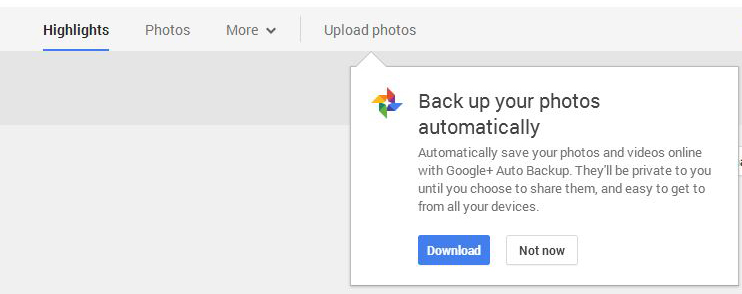
I've seen a few lists on here of Google alternative apps, and I've made the switch so far.
Google photos backup privacy free#
What I like about Google Photos is I can delete local files on my phone to free up storage, and the photos are saved offsite.ĭoes Owncloud do this? Or any other alternatives recommended for a private cloud backup solution? Maybe Synology will do what I'm looking for? I'm not exactly looking for a two-way sync, I just want an easy solution that will push changes on my phone to a server, and perhaps ability to browse remote files. I tried installing Syncthing on my desktop at home and my Galaxy S8, and got them to talk together, but it seems convoluted and doesn't easily push files and folders to the desktop/server end. I think this is a huge need for me, for example if my phone gets seized or stolen, my videos and photos will automatically be backed up off the phone for me. Been using Google photos backup to backup my photos on my phone immediately after they are taken. Thanks to this sub, I removed myself entirely from the Google services, with a few exceptions. Users no longer need to be wary of when the public cloud vendors are going to start charging for additional subscription fee so photos or data need to be migrate elsewhere, nor do users have to worry about photo management issues such as data loss, scattered photos, and the recurring fee that is more significant than it seems in the long run.First time posting here, been lurking and searching for a while. To turn it up a notch, a handful of NAS devices even have built-in image recognition and deep learning algorithm that assists users to group photos according to similar topics and categories.Ī scalable and efficient NAS storage device can be viewed as a once in for all photo management solution. Some NAS vendors even provide mobile apps and photo management appliance like Google Photos to not only help users to manage photo storage, share and access portfolios on the go, but also offer a modern browsing and uploading experiences for photos that users captured in daily life. Thus, NAS is an obvious choice when it comes to economic value. Not to mention that a NAS usually comes with 2 to 5 years of warranty.
Google photos backup privacy plus#
A 2-bay NAS device plus two 2TB NAS drives for RAID purpose still only add up to only around $450, which is significantly lower than using public cloud services in the long run. NAS on the other hand only requires initial hardware cost. If we use 2TB storage space as a benchmark, as mentioned earlier, if a user is determined to pay for a 2TB Google Drive storage space for $120 a year to save and maintain the integrity of his or her photo gallery, the total cost of ownership accumulated will grow to $600 in 5 years, and significantly and ultimately be a heavy burden for many people going forward. By seamlessly integrating the backup solutions with a NAS device, users can achieve various photo protection strategies without being wary of photos being lost or damaged.

NAS solution on the other hand is ideal because several NAS providers have a very complete backup applications ecosystem that helps users to deploy all around photo backup and data protection. On top of it, countless celebrity photo leak or data loss incidents from different public cloud providers were reported over the years, making more people aware that the notion of public cloud services being completely safe and secure is just untrue. Let’s take a look at why the aforementioned points give NAS an edge: Data protection and recoveryĭata loss often is due to human errors like accidental deletion, hardware failure, or ransomware attack. Though most of the tier-1 public cloud storage vendors such as OneDrive, Amazon Drive (opens in new tab), Dropbox (opens in new tab), or iCloud (opens in new tab) offer certain amount of free storage space, none of them exceeds Google’s whopping 15GB storage space, which means ultimately, it all comes down to upgrading public cloud storage plan regardless of the platforms.įor Google Drive (opens in new tab), though it seems like there are several plans available for upgrade, but if we consider smartphone (opens in new tab) and SSD-based laptop storage to be 256GB for most people nowadays, to store this amount of data on the cloud can cost you around $120 per year! The annually accumulated fee could be a considerable expense. Several remedies are available in the market at the moment, such as shifting towards other cloud storage (opens in new tab) services that offer freemium models, or simply upgrading google storage plan. As such change of policy projected to affect more than 1 billion users worldwide, many may start to wonder what they are ought to do with their existing or any other photos that are taken going forward.


 0 kommentar(er)
0 kommentar(er)
